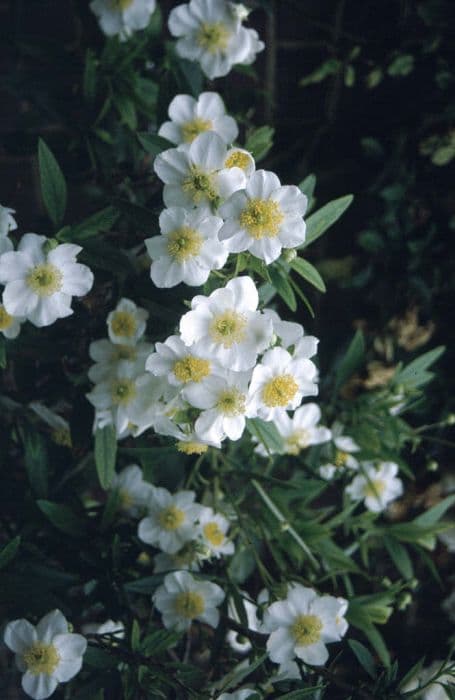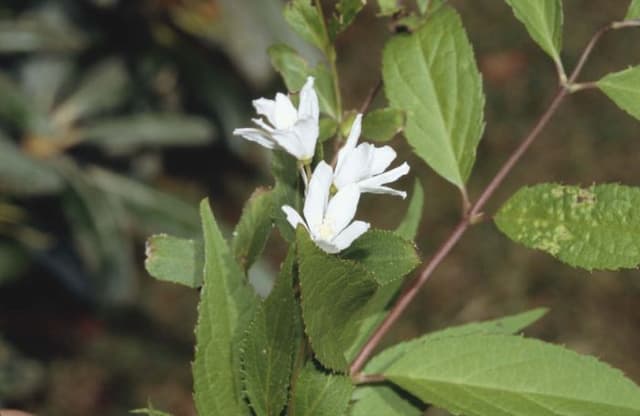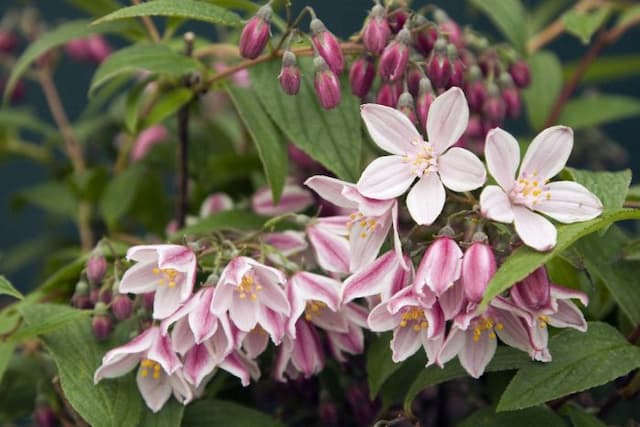Mock Orange Philadelphus 'Dainty Lady' (PBR)

ABOUT
Philadelphus 'Dainty Lady', commonly known as Mock Orange, is an ornamental shrub noted for its delightful, fragrant flowers. The plant boasts an upright, arching habit with numerous branches that create a somewhat rounded form. Its foliage consists of oval-shaped, dark green leaves that offer a lush backdrop for its blossoms. Throughout the flowering season, the Mock Orange dazzles with an abundance of delicate, cup-shaped flowers. Each bloom presents with four pure white petals that surround a center of prominent, yellow stamens, exuding a sweet, citrus-like scent. The blossoms appear in clusters, attracting pollinators to the garden while adding a touch of elegance. Overall, the 'Dainty Lady' cultivar presents itself with a graceful and refined appearance, contributing both visual and olfactory charm to any garden setting.
About this plant
 Names
NamesFamily
Hydrangeaceae
Synonyms
Mock Orange, Sweet Mock Orange, English Dogwood
Common names
Philadelphus 'Dainty Lady' (PBR).
 Toxicity
ToxicityTo humans
The plant commonly known as Mock Orange, including varieties such as 'Dainty Lady', is generally considered non-toxic to humans. There are no well-documented cases of poisoning from ingesting this plant. Therefore, it's unlikely that consuming parts of a Mock Orange would lead to significant adverse effects. However, it is still advisable to avoid ingesting plants that are not meant for human consumption as individual allergic reactions or stomach discomfort could occur.
To pets
The Mock Orange, including the 'Dainty Lady' variety, is not known to be toxic to pets. It does not appear on the list of plants commonly recognized as poisonous to animals such as dogs and cats. Ingesting parts of the Mock Orange plant is unlikely to cause poisoning symptoms in pets. However, as with all non-food plants, consumption can potentially lead to gastrointestinal upset, including symptoms like vomiting or diarrhea, due to the fact that it's not a normal part of an animal's diet. If a pet ingests a substantial amount of the plant and exhibits concerning symptoms, it is recommended to consult a veterinarian.
 Characteristics
CharacteristicsLife cycle
Perennials
Foliage type
Deciduous
Color of leaves
Green
Flower color
White
Height
4 feet (1.22 meters)
Spread
4 feet (1.22 meters)
Plant type
Shrub
Hardiness zones
5
Native area
Cultivar
Benefits
 General Benefits
General Benefits- Ornamental Appeal: The Philadelphus 'Dainty Lady', commonly known as Mock Orange, offers stunning white flowers with a delightful fragrance, enhancing the aesthetic appeal of gardens and landscapes.
- Attracts Pollinators: Its flowers provide nectar and pollen that attract bees and other beneficial pollinators, supporting local biodiversity.
- Low Maintenance: Mock Orange is known for being easy to care for, requiring minimal pruning and upkeep, which makes it suitable for gardeners of all levels.
- Durability: This shrub has a robust nature that can withstand a range of climate conditions, including cold temperatures once established.
- Versatility: It can serve various landscaping purposes such as being a focal point, a hedging plant, or part of a mixed border, giving gardeners creative options.
- Seasonal Interest: Aside from its spring blossoms, Mock Orange can also have attractive fall foliage, providing multi-season interest in a garden setting.
 Medical Properties
Medical PropertiesThis plant is not used for medical purposes.
 Air-purifying Qualities
Air-purifying QualitiesThis plant is not specifically known for air purifying qualities.
 Other Uses
Other Uses- Mock orange cut stems can be used for basket-weaving; their flexibility when young makes them suitable for crafting decorative baskets.
- The wood of a mock orange is hard and fine-grained, making it suitable for carving small objects such as utensils or ornaments.
- Because it's a dense shrub, mock orange can be pruned and shaped into living fences or privacy screens in gardens and landscapes.
- Dried mock orange flowers can be infused in oils to create fragrant potpourris or sachets for scenting drawers and closets.
- The hollowed out branches of the mock orange shrub can serve as natural tubes or pipes in crafting or garden irrigation systems.
- Mock orange can be trained to grow over arbors and pergolas, providing a living canopy with seasonal white blooms.
- When in bloom, mock orange can serve as a beautiful, natural backdrop for outdoor events like weddings or garden parties.
- Its dense foliage offers nesting opportunities for birds, supporting local biodiversity within a garden setting.
- Mock orange branches can be used in art installations or set designs that require a natural, woody element.
- The intense fragrance of mock orange blossoms makes them ideal for inclusion in homemade natural perfumes or scented candles.
Interesting Facts
 Feng Shui
Feng ShuiThe Mock Orange is not used in Feng Shui practice.
 Zodiac Sign Compitability
Zodiac Sign CompitabilityThe Mock Orange is not used in astrology practice.
 Plant Symbolism
Plant Symbolism- Innocence: The pure white flowers of the Mock Orange, which Philadelphus 'Dainty Lady' is a variety of, are often associated with innocence and purity, reminiscent of its delicate and pristine blossoms.
- Peace: The calming scent and appearance of the Mock Orange's blooms can symbolize peace and tranquility, inviting a serene atmosphere into the garden.
- Eternal Love: With its hearty growth and recurring flowers, the Mock Orange is sometimes symbolic of everlasting love, representing fidelity and a bond that lasts a lifetime.
- Brotherly Love: The name Philadelphus itself is derived from Greek, meaning "brotherly love," symbolizing kinship and affection.
- Memory: In the language of flowers, Mock Orange can also symbolize remembrance, making it a fitting tribute for lost loved ones or cherished memories.
- Renewal: As a plant that bursts into bloom in spring, the Mock Orange can also represent renewal and the start of new beginnings.
 Water
WaterMock Orange should be watered deeply to ensure water reaches the root zone, especially during dry spells, which equates to about 1 inch of rainfall per week. It is often best to water early in the morning to allow foliage to dry out during the day, reducing the risk of disease. Depending on weather conditions, this may translate to watering once or twice weekly. A good method is to apply water slowly at the base of the plant, avoiding overhead watering that can lead to fungal diseases. For a newly planted Mock Orange, use approximately 2 gallons at each watering, tapering off as the plant establishes.
 Light
LightMock Orange thrives best in full sun to part shade, with at least 6 hours of direct sunlight daily being ideal. Partial shade can be beneficial in very hot climates, but too much shade can reduce blooming. Place the plant in a spot where it receives bright but indirect light in the afternoon if possible, to prevent scorching of the leaves during hot summers.
 Temperature
TemperatureMock Orange is hardy and can withstand temperatures as low as 10 degrees Fahrenheit, but they grow best when the temperature ranges between 60 and 75 degrees Fahrenheit. It is advisable to plant them in a location where they are protected from harsh winter winds. During extreme heat, providing some afternoon shade can be advantageous to prevent heat stress.
 Pruning
PruningPruning Mock Orange is important to maintain its shape and encourage healthy growth and flowering. Prune right after it finishes blooming since it flowers on the previous year's growth. Remove any dead or damaged wood, and thin out about one-third of the stems to ground level to promote new, vigorous growth. Pruning can be done annually or every few years as needed.
 Cleaning
CleaningAs needed
 Soil
SoilThe best soil mix for Mock Orange 'Dainty Lady' is well-draining, fertile loam enriched with organic compost. The ideal soil pH for this plant should be neutral to slightly acidic, around pH 6.0 to 7.0. A ratio of 1 part garden soil, 1 part compost, and 1 part perlite or coarse sand can create a suitable environment for healthy growth.
 Repotting
RepottingMock Orange 'Dainty Lady' is typically grown as a garden shrub and does not often require repotting. If grown in containers, repot every 2-3 years or when the plant becomes root-bound, ensuring to increase the pot size to accommodate growth.
 Humidity & Misting
Humidity & MistingMock Orange 'Dainty Lady' prefers moderate humidity levels typical of outdoor environments. It thrives in conditions that replicate its natural habitat, so no special humidity adjustments are usually required.
 Suitable locations
Suitable locationsIndoor
Place in bright, indirect light with some direct sun.
Outdoor
Plant in well-drained soil with access to full sun.
Hardiness zone
5-8 USDA
 Life cycle
Life cycleThe Philadelphus 'Dainty Lady' (PBR), commonly known as Mock Orange 'Dainty Lady', begins its life cycle when a seed germinates, usually in the spring after a period of cold stratification which simulates winter conditions. The seedling then develops into a young plant with a root system, stems, and leaves, a stage that can last for one to several growing seasons. As the plant matures, it enters the flowering stage, typically in late spring to early summer, producing fragrant white flowers that attract pollinators. After pollination, the flowers develop into small, dry capsules that contain seeds, which are then dispersed by various means, including wind and animals. The plant can also spread vegetatively through rooting stems or suckers, creating new clonal plants at the base of the parent. Over time, the Philadelphus 'Dainty Lady' may enter a period of dormancy in the winter, losing its leaves and conserving energy until the conditions are favorable for growth in the following spring.
 Propogation
PropogationPropogation time
Spring-Early Summer
The most popular method for propagating Philadelphus 'Dainty Lady', commonly known as Mock Orange, is through softwood cuttings. This is typically done in late spring to early summer when new growth is mature enough to be firm but still retains some flexibility. Cuttings should be about 4 to 6 inches long (10 to 15 cm) and contain at least three or four nodes. The lower leaves are removed from the cutting, and the base of the cutting is dipped in rooting hormone to enhance root development. The prepared cuttings are then inserted into a well-draining propagation mix, with the nodes buried where leaves were removed. The environment should be kept humid and the cuttings should be placed in indirect light until roots have developed, which usually takes several weeks. Once rooted, the cuttings can be transplanted into individual pots and grown on before planting out into the garden.







![Hydrangea [Strong Annabelle]](/_next/image?url=https%3A%2F%2Fplants-admin.emdemapps.com%2Fimages%2Fplants%2F%2Fimages%2F604b54db37d34.png&w=640&q=75)

